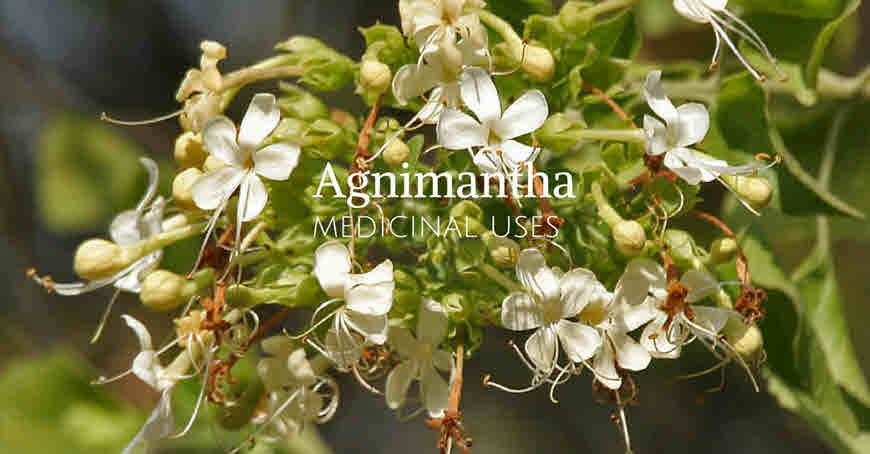Agnimantha or Arani(Clerodendrum phlomidis synonym Volkameria multiflora ) is a significant Ayurvedic medicinal herb. It is constituent of Dashmul, the famous Ayurvedic group of ten roots that is used to treat constipation, fever, weakness, loss of appetite and puerperal diseases.

There are two plants that are used as Agnimantha or Arani herb. One is Premna integrifolia (Badi Arni) and other is Clerodendrum phlomidis (Choti Arni). Both belong to same family Verbenaceae but are different plant.
In Ayurveda, the other common names of Agnimantha are Arani, Jaya, Vaijayanti, Munjavere, Ganikarika, etc.
General Information
Agnimantha tree is found distributed throughout India. Cluster of flowers appear during spring season. The flowers are white or pinkish and are very aromatic. After flowering it bears small fruits. The leaves of herb are also aromatic. The tree is called Agnimantha as rubbing two woods of the tree generates fire.
Scientific Classification
- Kingdom: Plantae
- Subkingdom: Tracheobionta
- Division: Magnoliophyta
- Class: Magnoliopsida
- Order: Lamiales
- Family: Verbenaceae
Vernacular name
- BENGALI: Ganiyari, Arani, Goniari
- GUJARATI: Arani, Aranimula, Arni
- HINDI.: Urni
- KANNADA: Taggi, Taggi Beru
- MALAYALAM: Munja
- MARATHI: Takalimula
- ORIYA: Ganiary
- TAMIL: Tazhutazhai
- TELUGU: Taluki
- SANSKRIT: Arani, Agnimantha, Jayanthi, Tarkaari SIDDHA: Pachumullai, Erumai munnai FOLK: Agethu
In Ayurvedic Pharmacopeia of India, the description of the plant Clerodendrum phlomidis (synonym Volkameria multiflora) is given as Agnimantha. Both Clerodendrum phlomidis and Premna integrifolia are used as Agnimantha in preparation of Ayurvedic medicines.
Clerodendrum phlomidis: Synonym C.multiflorum. Also known as Laghu Arni, Choti Arni, Tarkaari;Smaller variety of Agnimantha. It is a large bush or a small tree that is found in drier parts throughout India. The roots are contain ceryl alcohol, clerodin, clerosterol and clerodendrin A.
Premna integrifolia: Synonym P. obtusifolia;P. corymbosa. Badi Arni. It is a large shrub or a small tree distributed on the Indian and Andaman Coasts, plains of Assam and Khasi hills. This tree is also known as Agethaa, Ganiyaari.
The drug part of herb (Clerodendrum phlomidis) or Roots;7-15 cm long, 0.2 -3.0 cm thick, occasionally branched, cylindrical, tough, yellowish-brown externally, bark thin, occasionally easily peeled, outer surface rough due to exfoliation, wood light yellow, fracture hard;taste, slightly astringent.
Agnimantha roots are Tonic, stimulates urine production, fever reducing, anti-diabetic, anti-inflammatory and cough reducing. The roots are used in urine retention, painful urination, weakness, nervous disorders, etc.
Ayurvedic Properties and Action of Agnimantha
- Following is given Ayurvedic properties and action of Agnimantha on the body.
- Rasa (Taste): Tikta/Bitter, Katu (pungent) kashaya/Astringent,
- Guna (Characteristics): Laghu/Light, Ruksha/Dry
- Virya (Potency): Ushna/Hot
- Vipaka (Post Digestive Effect): Katu/Pungent
- Action on body: Hot in potency reduces phlegm, reduces wind/Vata
Dose:12-24 gm of the drug in powder form for decoction (Ayurvedic Pharmacopeia of India).
Agnimantha is ingredient of many Ayurvedic medicines such as Chayanprash, Dashmularishtha, Dashmool Ghrita, Narayan Taila, Gorochandi Vati, etc. It is one of the ten roots of famous Ayurvedic formulation Dashmula (Ten roots). For the medicinal purpose generally the roots and leaves of Agnimantha tree is used.
Uses of Agnimantha
Agnimantha roots are used in the treatment of a variety of diseases such as inflammation, jaundice, pile, constipation, impaired digestion, gulma, painful urination and retention of urine. The decoction of roots is used for obesity. In the case of erysipelas (bacterial skin infection involving the upper dermis) and glandular enlargement, the paste of Agnimantha and bamboo leaves is applied externally.
For freckles, the bark paste in milk is applied topically. The roots of the tree are boiled in water to make decoction and given in a dose of 100 ml to treat swelling in the body. In gout, the decoction of all five parts of tree/panchang is given. In urticaria, root powder is given in a dose of two grams with desi ghee for six days. The decoction of root is also useful in blood purification and treating skin diseases.
The leaves of the tree are also of medicinal importance. The cooked leaves of the tree eaten as Saag help to reduce abdominal gas and discomfort. In constipation, the leaves and Haritaki decoction is given. In piles, the decoction of leaves is given and poultice is applied on the affected body area.